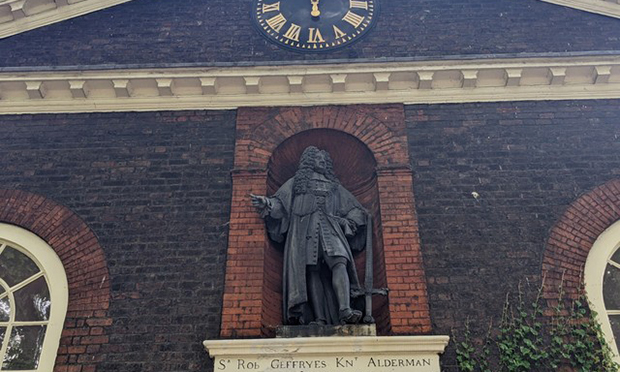Local museum renews pledge to move slaver statue overlooking its entrance – a year after its original promise

The statue of Robert Geffrye stands over the museum’s entrance. Photograph: Julia Gregory
A local museum has renewed its pledge to move a statue of a merchant who made money from slavery from its entrance – a year after telling campaigners that it would do so.
Hackney Stand Up to Racism (HSUTR) wants to see the back of the statue of Robert Geffrye, which stands over the entrance to the Museum of the Home on Kingsland Road.
The campaign group has staged multiple protests at the museum, and the National Education Union also joined a boycott, with members pledging not to take school trips there.
HSUTR now wants to see action taken a year after the museum’s vow to remove the statue.
The group said: “Sadly it has not carried this out. Despite the museum’s efforts to reflect the diversity and multicultural nature of London the offensive statue of a slaver still stands in its honoured position over the museum as an insult to Black and Asian attendees.”
Campaigners added: “We call on the Museum of the Home to honour the wishes of the people of Hackney, and bring down the statue of the slaver Robert Geffrye.”
The statue is positioned over the entrance doors of almhouses that he funded, and predates the foundation of the museum, which eventually took over the historic building.
Geffrye made part of his fortune from the transatlantic slave trade and was involved in the Royal African Company and the East India Company. He also part-owned a slave ship.
The buildings on Kingsland Road were later used as a museum that took his name. It has since been rebranded as the Museum of the Home.
A spokeswoman for the museum said it intends to move the statue of a man who “profited directly from the buying and selling of human beings. These profits were very likely sufficient to fund the core part of his legacy.”
However the museum stressed: “There is no connection between Geffrye and the founding of the museum and its collections.”
Calls for the statue to be removed increased in the wake of the Black Lives Matter protests sparked by the murder of George Floyd. It saw towns throughout the UK look at the statues of people who made fortunes from enslavement.
In Bristol, the statue of Sir Edward Colston was pulled down by protesters. Colston was also involved in the Royal African Company, which shipped an estimated 84,000 people from Africa into enslavement.
Hackney residents have said that they find it offensive that the statue is over the main entrance to the building.
A museum spokeswoman told the Citizen: “The Museum of the Home strives to be a welcoming place for all. We feel that the statue of Robert Geffrye on the front of the Museum’s buildings does not promote the sense of belonging that is so important for our visitors, and fundamental to the museum’s values.”
She said displays have been created to “address some of the issues raised by the statue’s presence while the process of its repositioning is ongoing”.
Museum staff have been working with young people from and around Hackney through social justice charity Voyage Youth, which works to empower young Black residents to look at “the possible relocation, display and interpretation of the statue – with community considerations at the forefront”.
The museum said: “We believe there is potential to retain the statue on site but in an alternative and less prominent space, where we can better tell the full story of the history of the buildings and Robert Geffrye’s life, including his involvement in transatlantic slavery.”
The spokeswoman added that staff have “listened to many views and considered all options concerning the display of the Geffrye statue”.
The museum held a consultation in 2020 of more than 2,000 people, the majority of whom wanted the statue moved.
It emerged later the same year that then culture secretary Oliver Dowden put pressure on the Museum of the Home to keep the statue.
He wrote to organisations across the UK to say that “confronting our past may be difficult at times” but “we cannot pretend to have a different history”.
He said: “Historical objects were created by previous generations, who often had different perspectives and different understandings of right and wrong. But though we may now disagree with those who created them or who they represent, they play an important role in teaching us about our past, with all its faults.”
He added: “I understand that as national organisations you have an important role to play in facilitating and contributing to these timely debates.
“As a government-funded organisation, I would expect you to be mindful of the above approach, which has been agreed with Historic England. If you plan to make any statements or actions in relation to this issue, please contact DCMS (Department of Culture, Media and Sport) in advance of doing so.”
Listed building consent would have to be given before the statue can be moved.
Hackney’s Mayor Philip Glanville said this week: “We are speaking to and working with the Museum of the Home to oversee the repositioning of the Robert Geffrye statue, and will continue to collaborate with community leaders, cultural experts, historians, teachers and young people to make sure that Hackney’s public spaces are representative of the communities that live in the borough.”
